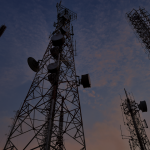You can download the PDF version here.
Pakistan has witnessed a high degree of activity in the EdTech segment, as numerous platforms and services emerge to offer new learning solutions that either add to or complement existing channels. The need for more content and increased accessibility is obvious, given chronic gaps in learning outcomes. A number of technology-centric service providers played a critical role in supporting timely and efficient responses for education continuity as both the Covid-19 pandemic and the devastating superfloods of 2022 disrupted normal education delivery. The most recent macro level effort in Pakistan’s EdTech portfolio was the Ministry of Federal Education and Professional Training (MoFEPT) TeleSchool Pakistan mobile app.
While leveraging technology to provide learning support for Pakistani students holds immense potential for bridging educational disparities, it is crucial to assess how well such efforts address the specific needs emanating from the country’s fragmented education system and diverse population. For a system that experiences frequent interruptions to the education system—because of climate, public health and political crises – new interventions must introduce innovative approaches that are built upon previous interventions, anchored in evidence and designed to offer continuity and contribute to improved outcomes.
TeleSchool Pakistan App: An Overview
Three years ago, just when education around the world had been disrupted by the Covid-19 pandemic and Pakistan was experiencing school closures affecting more than 40 million students[1], the government introduced and piloted a dedicated TV channel with free education content available to a vast majority of Pakistani households. Implemented almost instantaneously, the TeleSchool TV channel was a remarkable demonstration of government capacity and the potential for private sector contributions to complex and sophisticated crisis responses[2]. The TeleSchool TV channel broadcast teaching and learning content for a number of subjects covering Grades KG to 12 from 8 am to 6 pm daily on the nationwide terrestrial Pakistan Television Network (PTV). With 74% ownership of televisions among households in Pakistan, terrestrial TV was chosen as the primary medium for education delivery response during Covid19 school closures[3]. Several other public sector programmes were introduced alongside TeleSchool as a response to Covid-19. These include Radio School, TaleemGhar (Punjab) and the e-taleem portal, which utilise various channels, including online websites and radio to deliver learning material to students.
The launch of the TeleSchool app in March 2023 is an important leap for the delivery of learning material and education at large. Given that this app has been introduced just three years after the Teleschool TV channel, it manifests more sophisticated and rigorous thinking in the public sector about how Pakistani education futures. The aim of the TeleSchool app is to “revolutionise formal education in Pakistan using digital technologies” and reflects the government’s efforts to drive “innovation”[4]. Similar to the TV channel, the TeleSchool Pakistan app is a government led project powered by partnerships with private educational platforms namely Knowledge Platform, Sabaq, Taleemabad, Learning Pitch and Nearpeer[5]. It is notable that the TeleSchool story now encompasses two political regimes, in an ecosystem of intense political polarisation where the previous and current governments are otherwise severely opposed to each other.
While both variants i.e., TeleSchool TV channel and TeleSchool Pakistan app, offer free of cost learning resources for Grades KG to12, the app offers an enhanced feature set and more structured content in an attempt to expand the scope of opportunities to support education outside schools. The table below provides an overview of the two TeleSchool variants:
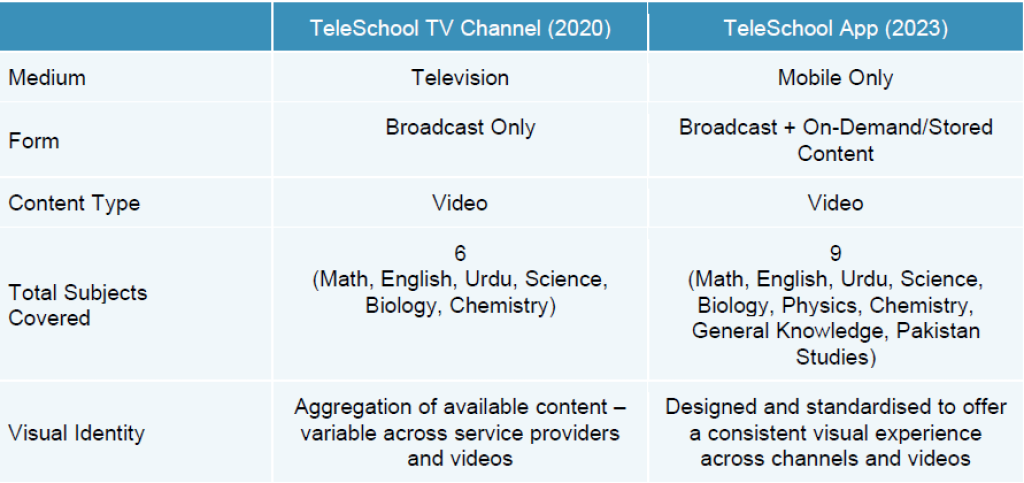
We now cover the two key features of the TeleSchool App – live channels (broadcast through the mobile app), and on-demand grade and subject-wise content:
Live Channels
The TeleSchool Pakistan app consists of six Live Channels that broadcast content continuously. These channels are currently only available on the app and follow a weekly broadcast schedule.

Four of the six educational channels are dedicated to school-going children covering specific grades while two channels cater to out-of-school children.
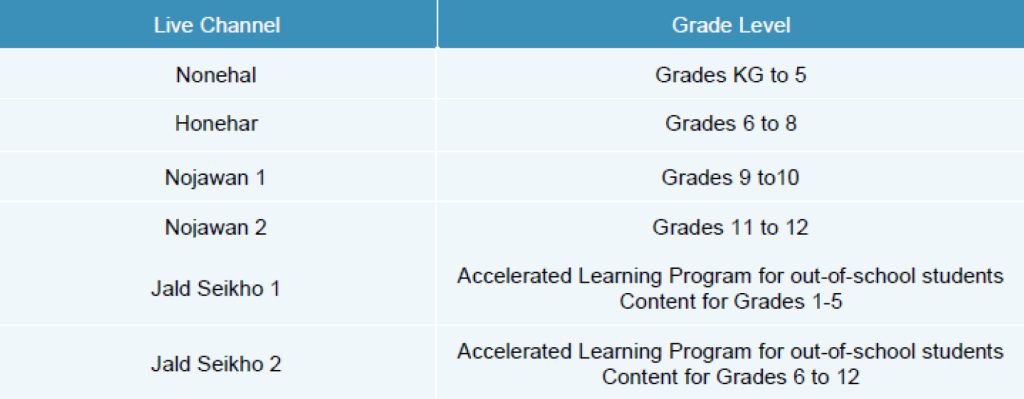
On-Demand/Stored Content
One of the major upgrades that the app offers, as opposed to the TV channel, is on-demand content availability. The TV channel was, by virtue of being broadcast only, limited to users viewing content as per the channel’s schedule. Amidst long electricity blackouts and power failures, and any number of other possible disruptions to user access to broadcast content, the app provides on-demand content for Grades KG to 12 in the form of videos—accessible as per user availability and preference. Another major upgrade is the improved content library that covers more subjects/topics and grades, organised by curricular learning outcomes. The content library in the TeleSchool Pakistan app already boasts 2,236 video packages across all grades and subjects – curated specifically for this app[6].
In the short time since its launch, the TeleSchool Pakistan app garnered impressive engagement—surpassing 30,000 downloads, 43,000 registered users and accumulating over 50,000 video views[7]. This highlights its potential as a valuable tool for supporting students who fall into two categories: a) those attending school but in need of additional assistance to improve learning processes and outcomes, and b) those who are no longer a part of the formal education system and can benefit from learning opportunities. However, it is imperative that we go beyond these initial markers of success and delve deeper into evaluating interventions with a focus on the app’s potential contribution to scaled adoption and demonstrable improvement in learning outcomes.
TeleSchool App: A rapid review
The TeleSchool Pakistan app characterises key elements and features that are central to educational apps. These include:
Easy to install and sign-up
Available for Android and Apple users through their respective app stores, TeleSchool Pakistan is easy to install and requires one-time registration to start using the app. Once registered and an account has been created, there are no further onboarding processes, and content can be accessed right away.
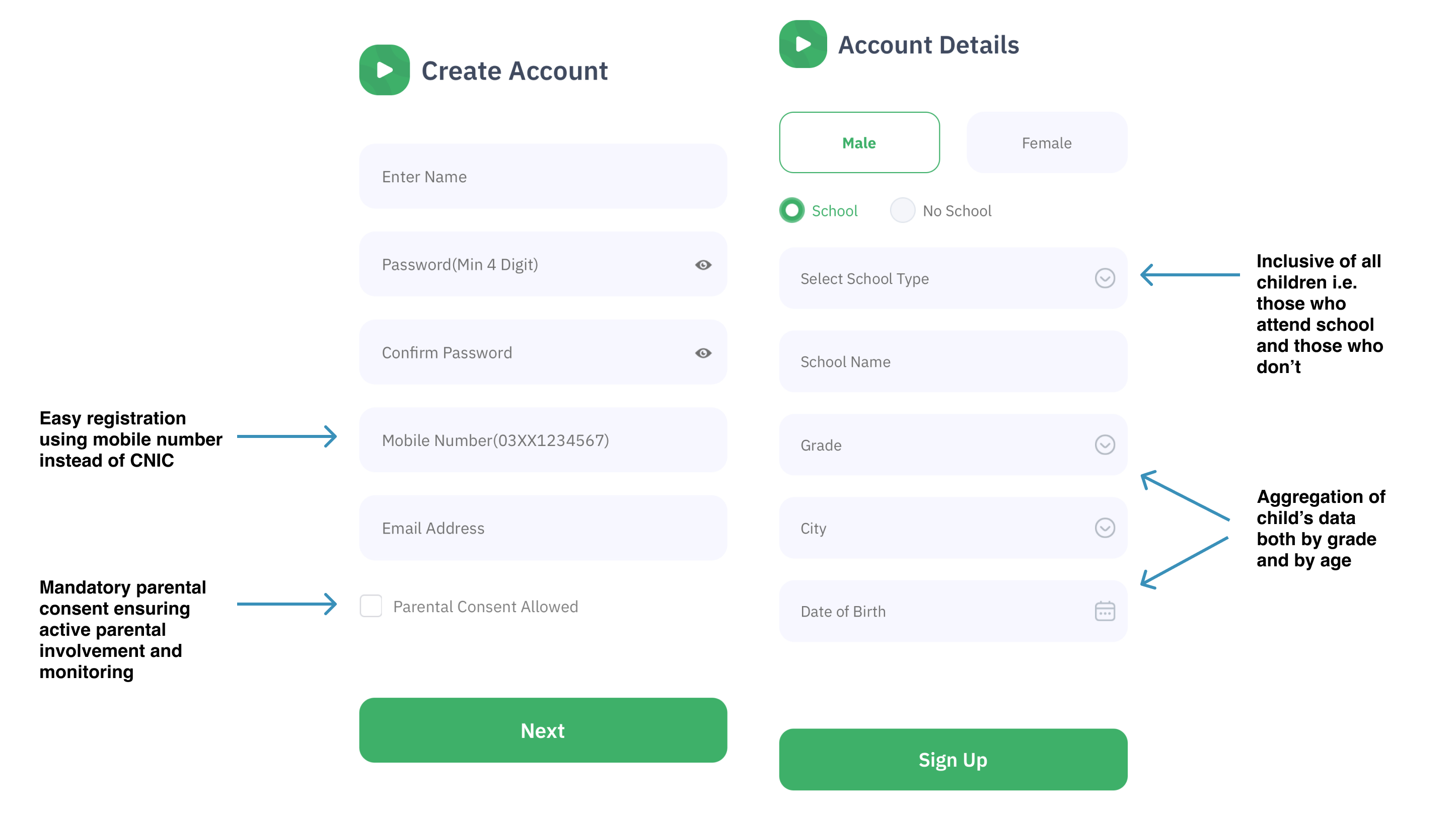
The app offers users the ability to create multiple accounts with a unique mobile number, catering to multi-children households whereby different profiles can be created by entering details of all children that can use the app. This allows families to access relevant content streams conveniently on a shared phone. In addition to students, the app also allows teachers to sign up, with similar registration steps with the only difference of linking registration to the Computerised National Identity Card Number (CNIC).
While the app requires parental consent through a checkbox, it does not offer any additional robust means of verification/validation of the parental consent.
User-Friendly Interface
The landing interface of the application offers a creative and user-friendly design and navigation. Every section and tab has a clutter-free and attractive design, featuring clear labels that make it engaging for users, particularly children, to explore.
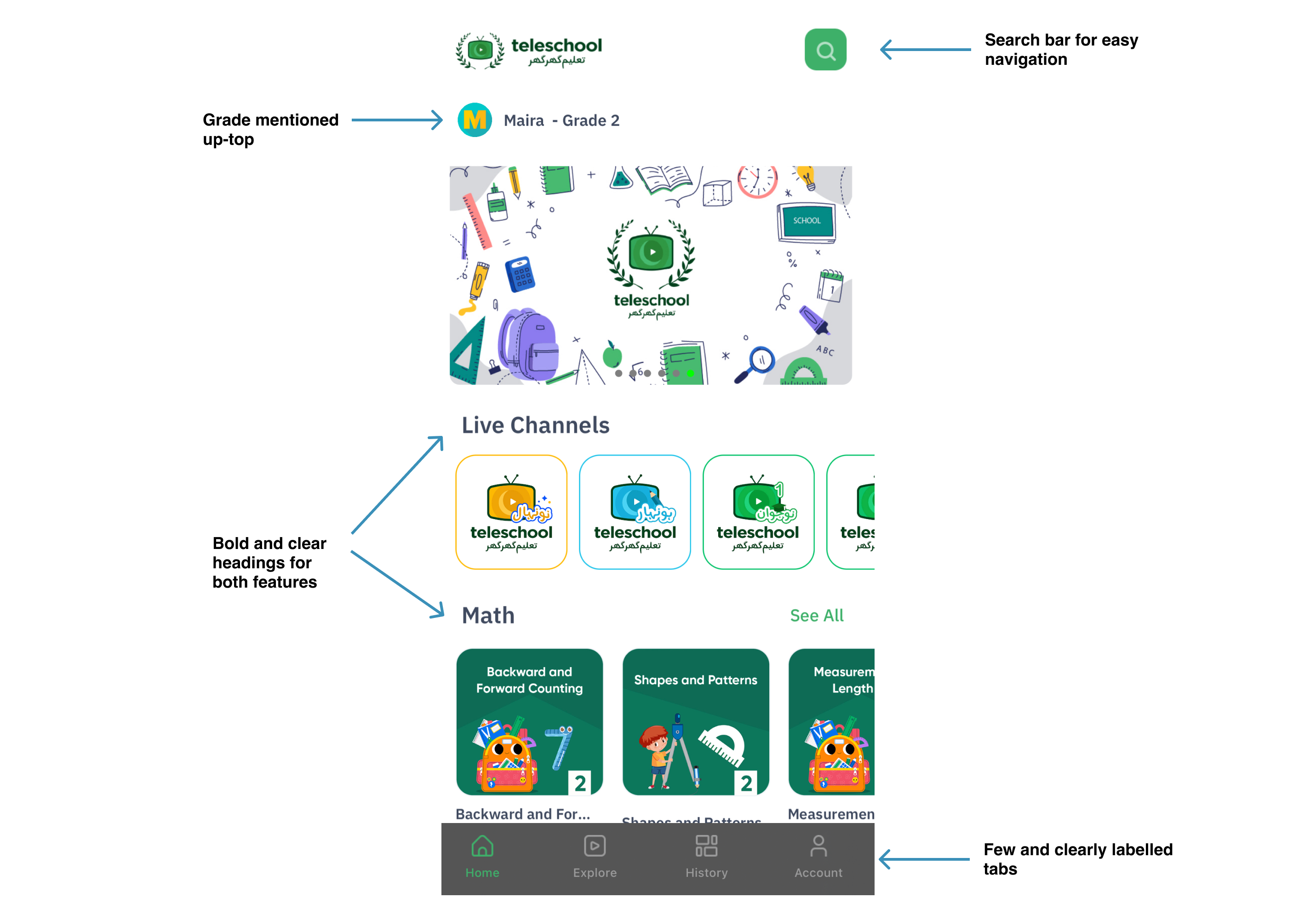
Expanded coverage and content library
The TeleSchool channel initially encompassed six subjects: Math, English, Urdu, Science, Biology, and Physics. The app, however, offers additional subjects including Chemistry, General Knowledge, and Pakistan Studies. This expansion of the subject list showcases MoFEPT’s commitment to ensuring that learners spread across all levels have access to a wider spectrum of content to support their educational experiences.
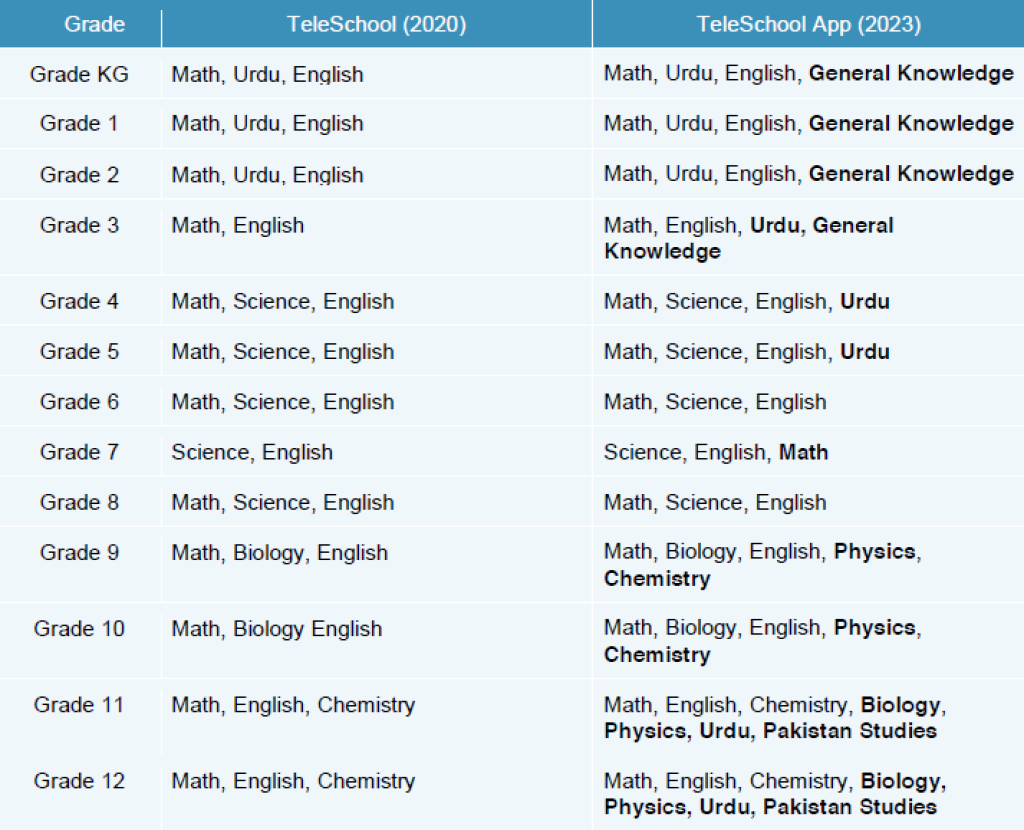
Content Enrichment
To enhance the learning experience, the app leverages external resources such as TED Talks and YouTube channels to augment in-app content for each grade and subject covered in alignment with the national curriculum. These linkages to external resources provide an expanded set of aids to facilitate lessons undertaken through the app. Moreover, the videos cover a range of topics covering life skills and general knowledge, which can be invaluable in developing key behavioral competencies like problem solving, critical thinking and collaboration among children.
Feedback Response Mechanism
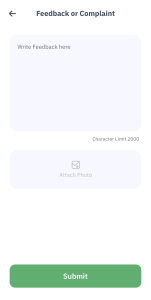
The app introduces a critical feature of soliciting user feedback and complaints. This sets it apart from traditional mediums like television, where individuals are required to make phone calls and manually report inconveniences, as a low-probability channel of engagement. Having an in-built feedback mechanism allows the process to become simplified and streamlined, encouraging users to express their thoughts more easily and frequently. On the other hand, by effectively utilising information and insights through feedback, MoFEPT can benefit immensely through clearly identified areas for improvement in design and content. These feedback loops can lead to upgrades that can ultimately enhance the overall user experience.
Inclusive approach catering to out-of-school children
In addition to covering content for all grade levels, the app through its newest addition of a Live Channel also caters to out-of-school children. This content primarily is designed to be an accelerated learning program for children who may have dropped out or have never attended school. Given Pakistan’s out-of-school-children crisis, this is an area of high importance and can enable pathways for improved engagement and learning for these excluded groups.
But is this enough? Limitations and Shortcomings
While the TeleSchool Pakistan app is a notable addition to the bouquet of digital learning platforms, it also drives attention to the critical aspect of effectiveness; how can such interventions improve learning outcomes at scale? We now highlight some fundamental challenges and limitations of the TeleSchool Pakistan app.
Universal Access
While the TeleSchool Pakistan app is an innovation in the public sector context, its efficacy as a national solution is hindered by Pakistan’s digital readiness. Smartphone ownership in Pakistan stands at around 40%, and the state of internet connectivity is far from satisfactory[8]. Despite 2.3x growth in total broadband subscribers since 2016, less than half of the total population can avail broadband internet with sub-par quality and experience.[9]
This raises concerns about the target audience for such interventions. According to the latest Human Capital Review by The World Bank, the most vulnerable children in the education system are girls, children residing in rural areas, predominantly from Sindh and Balochistan and children who may never be able to afford schooling due to their socio-economic circumstances[10]. In all of the above-mentioned scenarios, these children face significant barriers in accessing smartphones and stable internet connections required to yield benefits from such an app.
Affordability
While the app is free to install and use, there is a cost associated with data usage to access content through the mobile app. Even for families who may own a smartphone, the increasing cost of fixed and mobile broadband due to high taxation coupled with other inflationary pressures that reduce the income available for connectivity requirements. Based on our usage of the app, approximately 40 minutes and 3 videos results in 500MB (0.5GB) of data usage. Projecting modest use of the app for 30-40 minutes a day over 10 days a month would require 5GB of internet usage. Given Pakistan is a mobile-first internet market with limited fixed broadband coverage, such internet usage for the app can cost households an additional PKR 400 to 800 per month[1]. This can act as a major barrier for households in the lower income quintiles which are subject to highest inflationary and other cost pressures.
Language
Although the app offers content in both English and Urdu, there is a prevalent language barrier, particularly in terms of interface elements. From the sign-up process to the labels in the main interface and video content, the interface of the app uses English. This can lead to alienation of children who may not have sufficient proficiency in reading and understanding English. Even parents, who are required to provide consent and active support to their children in using this app, may continue to face difficulty in navigating the app due to the language barrier. The absence of content adaptations that translate the primary content in commonly spoken regional languages including Punjabi, Pashto, Saraiki, Sindhi, Brahvi etc. certainly limits the adoption and use of the app as a universal platform for all Pakistani children.
Information and awareness
Other than the launch-hype around the app, there is no broadcast schedule available in the app or publicly for the live educational channels for users to know about the content coverage and modality. This lack of access to simple yet critical information leads to issues that inhibit an elaborate utilisation of the digital content available through the app.
Content accuracy and visual presentation
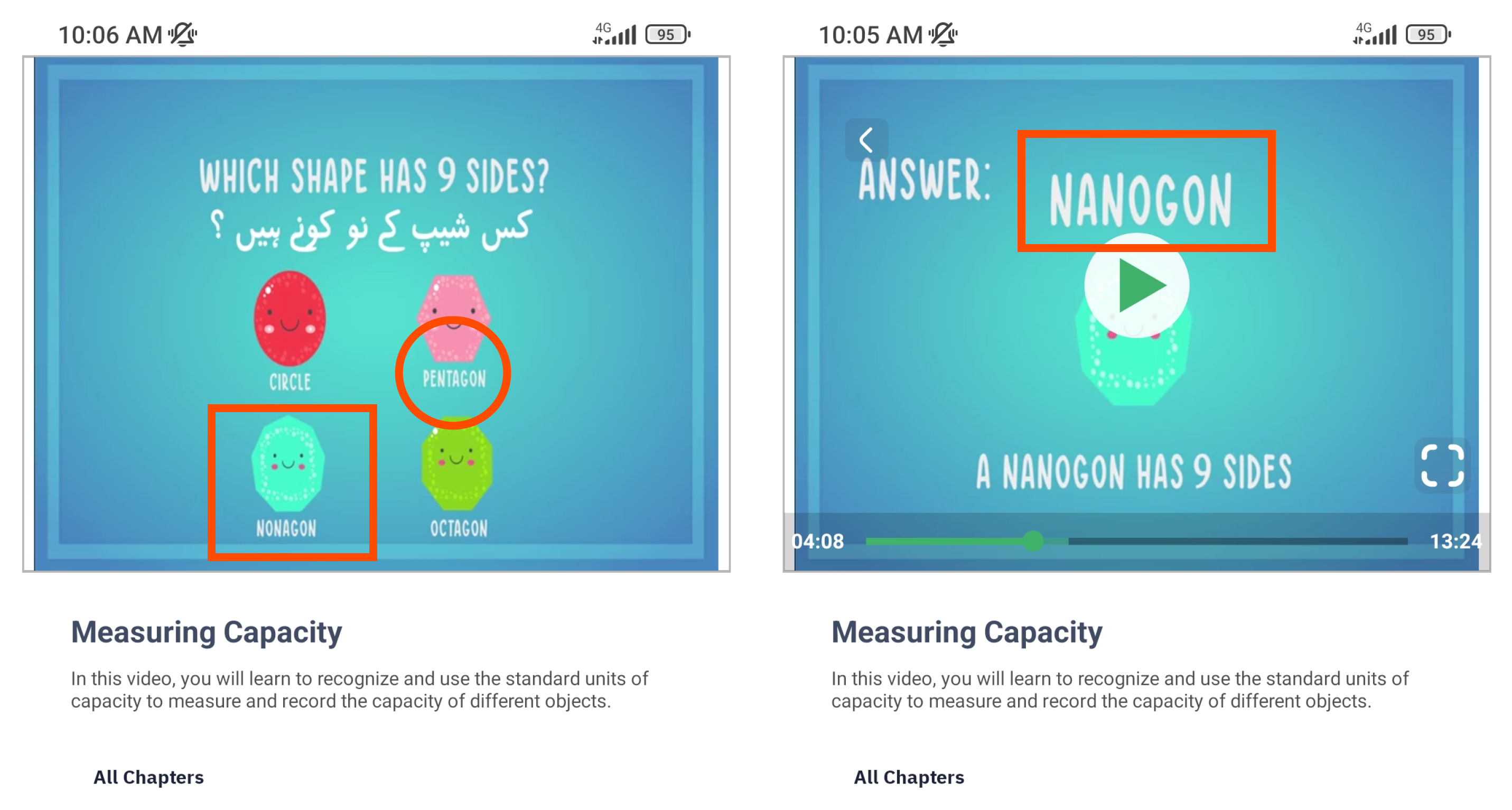
We found notable issues based on a very narrow-scope review of selected videos on the app. There are occasional interruptions and slight lags in the audio-visual sync where some sections lack the accompanying voiceover that provides an explanation of the content displayed on the screen or the sequence of content skips abruptly to a new section. These disruptions hinder the seamless viewing experience of the audience and makes it difficult for them to follow the instructional sequence. Furthermore, there are instances of spelling and conceptual errors that pose a risk of conveying inaccurate knowledge to students. For instance, a Math video for Grade 3, the word “nonagon” is spelled correctly in the question, but it is incorrectly spelled as “nanogram” in the subsequent answer visual. The shape marked as ‘pentagon’ is actually a hexagon. Content curation and quality assurance is a resource-intensive yet critical layer of launching such platforms. The MoFEPT must institute quality assurance layers and processes including proactive user feedback for identification and rectification of such errors before making them public and ensure that the videos are free from any lags and disruptions.
Assessments & measuring results
Any educational intervention must be designed to effectively measure results and evaluate impact on learning outcomes. Despite this fundamental principle, assessments remain a persistently neglected area in the design of learning interventions especially in various forms of urgent responses. While the app provides a large pool of learning content and in-video question and answer sections, the absence of a robust assessment mechanism in the form of formative and/or summative instruments that can generate data for MoFEPT is a significant drawback. Without the ability to assess student progress and learning, the true impact of the app remains uncertain and collection of critical insights, that can enable action-oriented decision making for a range of priorities including teacher training and remedial measures, is missed out.
Recommendations
Impactful learning interventions are carefully planned, well-designed and equipped with relevant content and features that cater to the needs of an education system at large. In our case, the education system is plagued with chronic issues of poor access and quality. This requires effort, coordination and collaboration by multiple stakeholders including relevant government agencies, education service providers, teachers and parents/communities. We outline areas that can be enhanced to improve the uptake and adoption of the TeleSchool Pakistan app and increase its effectiveness to contribute to improved outcomes.
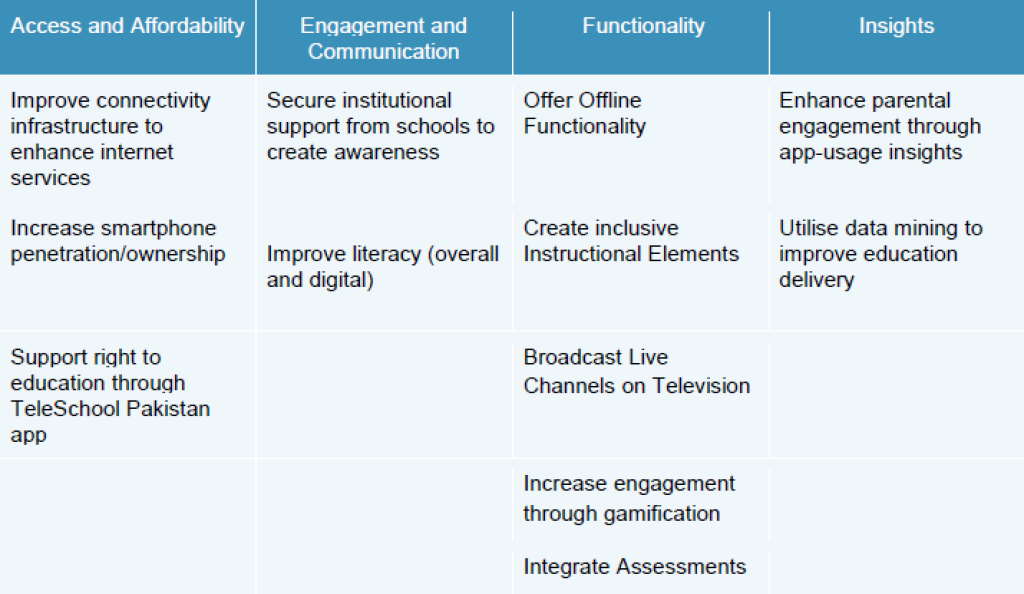
Accessibility and Affordability
Improve connectivity infrastructure to enhance internet services: With the internet penetration rate of 36%[11] and internet access gender gap of 67%[12], Pakistan’s core connectivity, fixed and cellular, remains a challenge especially in rural and remote areas. It is, therefore, essential to increase investments in connectivity infrastructure for expansion of the fiber optic network, improved coverage and quality of service across Pakistan. In addition to this, telecom providers must be facilitated in their efforts to strengthen mobile data networks to enable rich use-cases like consumption of education content. Cross-sectoral national priorities like the right to education as guaranteed by Article 25-A of the Constitution should be driving digital expansion for Pakistanis.
Increase smartphone penetration/ownership: Since mobile apps can only function on smartphones, it is crucial to increase smartphone penetration and ownership across the population. This requires making smartphones more affordable which can be achieved through increased local manufacturing of handsets and a reduced taxation on mobile devices, automatically bringing down the cost. Additional measures could include providing tailored subsidies/social transfers, installment plans and/or low-cost devices for households of varying socioeconomic backgrounds with clear metrics for education participation.
Support right to education through the TeleSchool Pakistan app: Regular usage of the in-app content will shift data consumption patterns and create affordability issues for lower income segments. Several measures can be taken to reduce the burden of cost on users. TeleSchool app can be made free for end-users through strategic collaboration with mobile network operators. This will entail agreements to pay for data usage and consumption of the TeleSchool app (at an aggregated level) directly to mobile operators. Enabled through bespoke arrangements for enterprise services, the requirement for users to pay for and/or consume data on TeleSchool app from their mobile plans can be eliminated and these interventions can contribute to fulfilling Pakistanis’ right to education and the concomitant responsibilities of the state.
Engagement and Communication
Secure institutional support from schools to create awareness: In addition to digital advertising, and promotion around launch bursts, schools in the public, private and non-profit segments can play an active role in raising awareness among students and parents about the TeleSchool app and its benefits in complementing their learning from school and improving academic performance.
Improve literacy (overall and digital): Due to low digital literacy and lack of trust in online platforms, community-focused trainings through vast school networks and education frontline staff can be helpful in educating parents and children on the benefits and usage of apps while also equipping people with the digital skills needed to navigate it effortlessly. This would help create familiarity with the opportunity set offered by online learning solutions in addition to the TeleSchool app and enable people to initiate personal digital transformation journeys.
Functionality
Offer offline content: As long as access to the internet is subject to shutdowns, cost escalations and low quality, it is crucial for any new digital education initiative to address the challenges faced by those with limited connectivity. Therefore, it is important that mechanisms to ensure offline access are introduced to support learning journeys. This feature will not only enable students and teachers to access the content readily and repeatedly on their phones but also limit the dependency on unreliable and/or expensive connectivity.
Create inclusive instructional elements: Given Pakistan’s low literacy levels, and even lower proficiency in English, having enabling interfaces that use local language and/or audio-visual prompts to support text-based navigation, can improve adoption across population segments. A language selection feature should be available up top to give users the freedom to choose their language of instruction. In the long term, the MoFEPT in collaboration with provincial education departments should also introduce content library adaptations in local languages to effectively serve Pakistan’s multilingual student population.
Broadcast Live Channels on television: Currently, live channels are only exclusively available on the app. This restricts access for households that do not have smartphones and/or internet connectivity. To address this issue, it is recommended to make the Live Channels available on television and web as well. While the current content is being broadcast on TeleSchool TV channel, new avenues to access content on flexible schedules on cable and other broadcast media especially for out-of-school children can create supplementary opportunities. Detailed market and segmentation analyses can inform the best scaling options to deliver high value for money.
Introduce gamification: Incorporating gamification elements, such as points, rewards, collaboration and healthy competition based on usage and progression in the app can enhance the user experience to reward positive behaviours. Moreover, it can offer an interactive mechanism for personalised learning and growth which is often missing in classroom settings. With information through usage statistics, gamification has the potential to boost app usage and adoption thereby driving user engagement.
Integrate assessments: Introducing assessments in the app is a critical feature that can generate insightful data streams for MoFEPT, Pakistan Institute of Education (PIE), partners and schools. Embedded assessments linked to each lesson/content item/concept/SLO can generate rich insights that can help drive service delivery and governance decisions with overlays from anonymised user data. In addition to planning decisions, such data points can also support increased parental engagement with learning processes, school administration and teachers. The assessment loops can also help improve the TeleSchool app, content and experience through adaptive learning pathways and refining pedagogical approaches reflected in the content pool.
Insights
Enhance parental engagement through app-usage insights: Although the app currently offers a history of watched videos, it would greatly benefit from providing a detailed analysis of the content consumed. This analysis could use profile information of grades and benchmarks including information such as the extent of content covered, subjects the child focuses on the most, completion rates, frequency of video views etc. By offering this level of detail, parents and children can assess their progression, coverage of content and focus areas to ensure they can leverage the app’s potential to the fullest.
Leverage data mining to improve education delivery: Information from app usage across student and teacher profiles, with due privacy protocols and anonymisation, can offer rich insights for education decision-makers. This can then lead to improve adoption through targeted information and communication campaigns, devising of plans to focus on deficiencies and gaps as reflected through the app, and the identification of opportunities to integrate learning from the analytics feed generated through the platform. A crossflow of data, information and insights from schools (public and private) and the TeleSchool Pakistan app can create an important stream of knowledge within the education ecosystem—one that currently relies on assumptions and strongly held convictions largely based on dated, weak or negligible data.
Conclusion
Any intervention by the public sector that originates from the TeleSchool initiative reflects the growing state awareness and capacity. However, the missed opportunity and national cost of poor learning outcomes, exacerbated by Covid-19 and the 2022 superfloods merits a much more elaborate, detailed and aggressive positioning for ecosystem-wide transformation. This is even more imperative given the deep-rooted economic and political crises that currently grip the country. More than three years after the Covid-19 early response, the TeleSchool app is a welcome addition to the landscape of public sector efforts to address Pakistan’s learning crisis. But the scope of possibilities and potential offered by technology is much wider than what this first generation TeleSchool app offers. This important initiative must now be followed up with a dramatically improved second iteration on a fast track – one that has federal and provincial buy-in, and whole of education sector value-addition built in.
Disclaimer: The views and opinions expressed in this piece are those of the authors and do not necessarily reflect the official policy or position of Tabadlab (Private) Limited.
End Notes
[1] Rough estimate based on variance in mobile data plans subject to volume and validity parameters across operators.
[1] ASER (2021). Measuring the impact of Covid 19 on education in Pakistan. UNICEf, ITA. https://aserpakistan.org/document/aser/2021/ASER_2021_Measuring_the_Impact_of_COVID_19_on_Education_in_Pakistan_FINAL_REPORT.pdf
[2]Tabadlab | Understanding Change. (2020). Pakistan Tackling Covid-19 in Education. https://www.tabadlab.com/wp-content/uploads/2020/08/Tabadlab-Covid-19-Response-Briefing-01-Education-April-17-2020.pdf
[3]Zubairi. A et al. (2021). Pakistan country-level research review. Edtech Hub. https://docs.edtechhub.org/lib/NZUHTJBG/download/RZFG5HD7/Zubairi%20et%20al_2021_Country-Level%20Research%20Review.pdf
[4]Government launches Teleschool app to provide online education. (2023). The Nation. https://www.nation.com.pk/21-Mar-2023/govt-launches-teleschool-app-to-provide-online-education
[5] Consultations with the Ministry of Federal Education and Professional Training (MoFEPT)
[6] Consultations with the Ministry of Federal Education and Professional Training (MoFEPT)
[7] Consultations with the Ministry of Federal Education and Professional Training (MoFEPT)
[8] Tabadlab’s calculations based on data provided by PTA and PBS
[9] Tabadlab’s calculations based on data provided by PTA and PBS
[10] Ersado, L et al (2023). Pakistan – Human Capital Review: Building Capabilities Throughout Life. The World Bank. Retrieved from https://openknowledge.worldbank.org/entities/publication/8748b7a7-7345-4298-9631-3f5f146c7007
[11] Digital 2022: Pakistan — DataReportal – Global Digital Insights, Digital, Digital 2022 (DATAREPORTAL), accessed September 1, 2022, https://datareportal.com/reports/digital-2022-pakistan
[12] Economist Impact: The Inclusive Internet Index, Supported by Meta,
https://impact.economist.com/projects/inclusive-internet-index/2022/country/Pakistan.




